| Sean McVeigh's MAME
Cabinet Project see MAMEWorld to figure out what on earth I'm talking about. You can contact me at arcade at beerbot.ca There have been 119742 visitors to this page since February, 2003!
|
|
| Introduction Design Cabinet Controls Interfacing PC Guts Audio Video Links |
  Introduction Having been born in 1976, I fully remember going to the Arcade at Sauble Beach where my grandparents had their cottage, and spending hours dropping quarters into my favorite games.. games like Tron, Space Harrier, Dragon's Lair, Afterburner.. you name it, I liked to play it. I would walk an hour in each direction between the main street and the cottage along the beach to spend my allowance. I don't fully remember how much sun I used to get on those weekends. Fast forward to 2003.. the arcade has either vanished entirely or has receded from its split-level, 3-storefront-sized magnificence into a secluded corner of a convenience store. A handful of lonely monoliths bleeping and flashing their wonders in advertisement as disinterested youth hurry home to twiddle their thumbs on the latest Z-Box,GameStation or SuperTenindo. Sad, isn't it? Well it needn't be!! While passing my years at the University of Waterloo, I was introduced to M.A.M.E. This wonderful little package was a collection of emulation software bundled with various frontends that emulated the various CPUs found inside many of the old arcade games. For the non-technical reader, an emulator is a program that mimics the behaviour of something else, in this case, your home PC mimics the guts of the old arcade games. When combined with ROM images dumped from the old games, the emulators essentially play out the game program stored in the ROM files. For all intents and purposes, you have recreated all the hardware of the original arcade machine inside your PC. What does this mean? It means you get to play all those great games exactly as they were intended, right down to the flashing INSERT COIN message that many of us still have burned into the backs of our retinas from childhood. Now, while MAME is quite good at emulating all of the guts of the old arcade machines, there is one thing that it can't quite emulate correctly: the human interface. Sure, you can use your keyboard or PC joystick or mouse to interact with these games, but it's just not the same unless you are standing up, bashing away at big fat buttons and beating the pulp out of some poor stick (or in the case of the trackball games, putting mile after mile on a friendly rolling ball). I always figured that others must have shared my views, but I hadn't bothered to look into the matter until very recently when a coworker mentioned something about the good-old-days of videogames. Well, I dusted off trusty old MAME (some archaic 5-year old version) and fired it up to demonstrate. Never have I seen so many eyes light up as the day that I showed this to those few guys at work--all who vividly recalled the glory days of the arcade. The next thing you know, I'm browsing the web, reading about all those brave souls that have gone before me and taken on the daunting task of doing what it was that was now nagging at me to be done. These people have built full-sized, functional arcade game cabinets that play hundreds or thousands of their old favorites. Each one tailored to the individuals games of choice. Some with two joysticks, some with one, some with trackballs, some with spinners. The seed had been planted.. there was no turning back... ...more... |